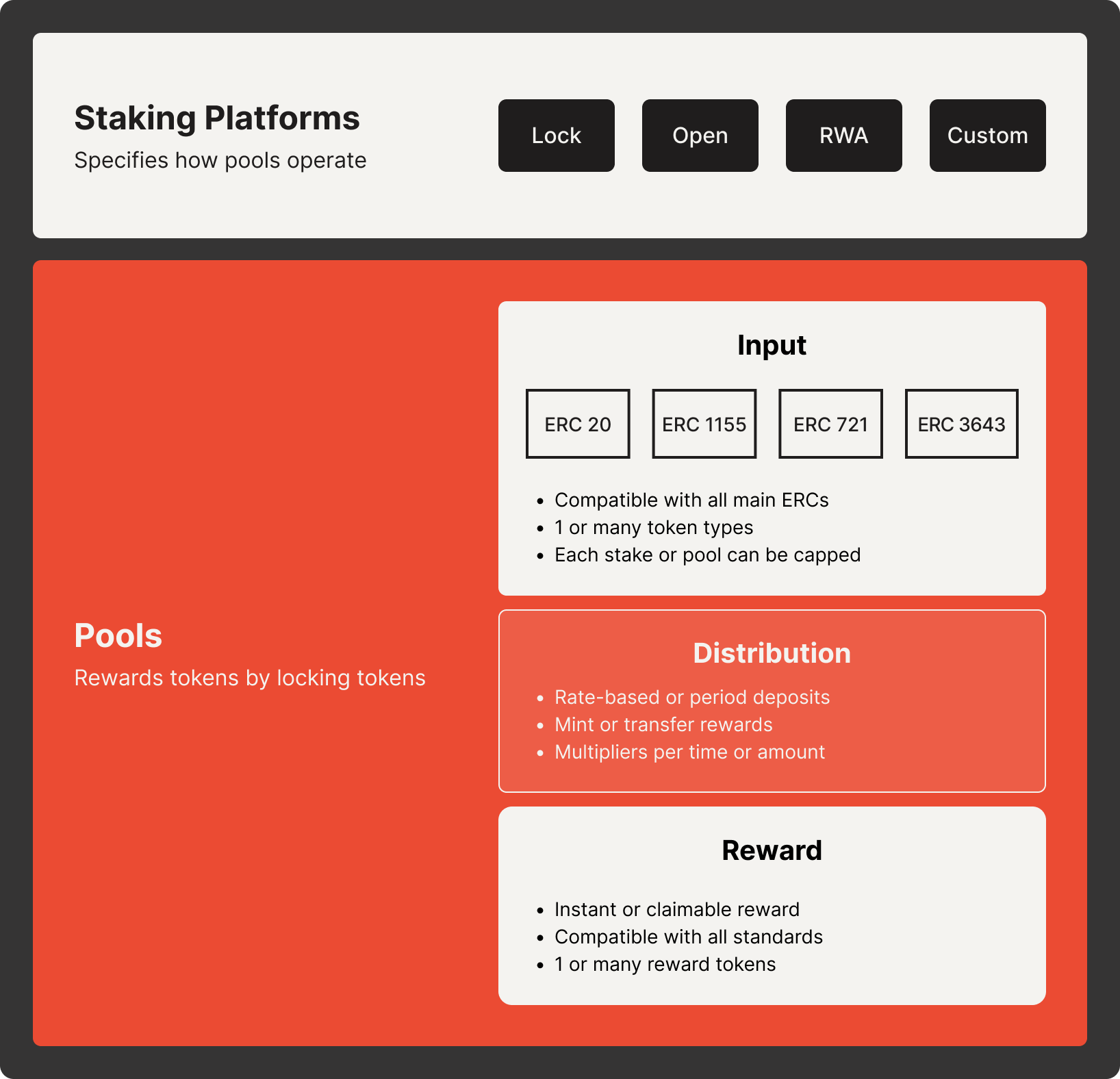Staking Platform
The staking protocol is a decentralized staking pool factory. Pools accept one or many tokens as inputs and reward stakers with another set of tokens.
Staking pools live in a staking platform that specifies how pools are constructed and who can issue or have access to them.

1. Platform and Pools
- Platform: factory of pools deployed by an admin. It can grant and manage roles and access, compliance rules with ComPilot, and specify token standards to stake and claim.
- Pool: Each staking pool operates within a platform and follows its rules. Staking pool issuers define the tokens to stake and to claim, and how they are distributed. Either through many airdrops for RWA or with direct mint permission for the Reputation use case.
2. Deploying a staking platform
Platform templates
Template | Description |
|---|---|
Reputation Lock | Earn a reward that is fixed, predictable, and calculated from the amount of input tokens staked on a specific timeframe. For instance, earn 10 Token B for every Token A staked every day. Reputation staking platforms have mint permission on the reputation token to be distributed. Here the investor locks his stake for a fixed duration and earns his reward during the stake. |
Reputation No Lock | Similar to the reputation lock template, except the staker can withdraw at any time and must claim their token. |
Real World Asset | Earn a reward that is not fixed and follows a specific period (daily, monthly...). The reward changes every period and is allocated proportionally to the user that stake in that period. Issuers must transfer manually the rewards to the staking pool. |
Compliance
Similar to sales markets, staking platforms can be gated by compliance rules operated and maintained by ComPilot. This feature is optional, creating gate-less staking pools within the platform.
Role
Role management is the same as with sales platforms.
Staking position token
When a user stakes in any staking pool of the staking platform, they receive a stake position token (an ERC_721) in exchange that acts as proof that the user has locked assets in the pool.
To deploy a staking platform, the admin must input the ERC_721 contract data, including its name, symbol, URI, and whether it is soulbond.
Pool duration
Specify what type of duration the pools within the platform will have:
- Start date only
- Start and end date
Pool amount
Specify whether each pool has a capitalization limit and whether stakers have deposit limits:
- All staking pools have hard capitalization (maximum amount of tokens to be staked)
- All stakers have a limit of tokens that can be staked in the pool
Tokens to stake
Compatible token standards to stake as input tokens include
| Token standard | Name |
|---|---|
| ERC-20 | Fungible Token |
| ERC-721 | Non-Fungible Token |
| ERC 1155 | Multi-Token Standard |
Lock duration
Administrators can decide whether the staking pool has locking periods for stakers. In other words, pools can block stakers from withdrawing their position for a specific time.
- Administrators can enable this feature and provide optionally the maximum lock period for all pools
- On the other hand, administrators can toggle off this feature
Multipliers
Reward multipliers provide the ability to offer bonuses to stakers based on the number of assets they stake or the locking period. Alternatively, administrators can remove this feature from their platform.
Interval: The respective amount multiplier is determined based on predefined staking amount intervals. The highest defined multiplier is applied for staking amounts exceeding the highest defined interval.Continuous: Each staking amount bin is associated with a linearly interpolated amount multiplier. If the staking amount exceeds the upper bound of the last bin, the highest defined multiplier is applied.
Updated about 2 months ago
